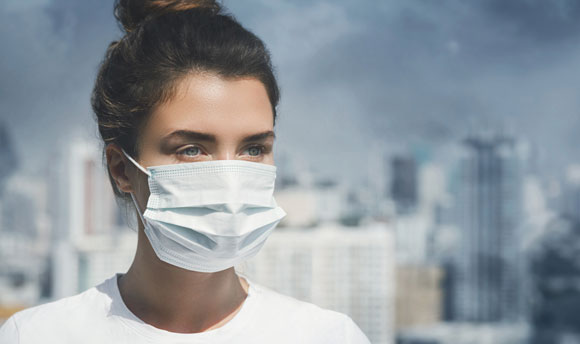Photos of medical teams and citizens with their faces obscured by masks have become the trademark of epidemics and outbreaks. But does the use of face masks really help protect against disease?
Airborne pathogens like the flu, SARS, and the novel coronavirus, which appeared in China in December 2019, are responsible for outbreaks of diseases and pandemics.
The transmission and infection of airborne viruses between humans can happen through close contact with respiratory droplets – when an infected person speaks, coughs, or sneezes, their respiratory system emits pathogen-carrying droplets. Droplet size is a little over 5 microns (0.005 millimeters), they are heavy and are not easily carried through the air. When these droplets come into contact with another person’s mucosal tissue, such as the nose, mouth, or eyes, they are likely to infect them. Transmission can also be indirect, when surfaces that have these droplets on them are touched.
Transmission between humans can also occur over greater distances. The droplets contain viruses, water, salts, and saliva. When the water evaporates, the droplets become tiny particles called aerosols, which are less than 5 microns in size. An aerosol that contains a pathogen is also known as droplet nuclei. These particles are easily carried through the air for a distance of several meters, and can also hover in the air for several hours.
In order to prevent transmission and infection through airborne pathogens, precautions must be taken that include personal hygiene, especially thorough handwashing, coughing and sneezing into your elbow or a tissue, and avoiding being around sick people.

Guidance is needed to correctly fit the mask to the face and remove it. A nurse using a N95 mask. Photo: Shutterstock
The right mask
Even though use of facemasks is not part of the official recommendations published by the World Health Organization (WHO) to the general public, some of the guidelines include the use of masks for medical staff, those who have been diagnosed with the disease, and their families. There are several types of facemasks – the main ones are surgical masks and respiratory protective masks.
Surgical masks cover the mouth and nose and are effective mainly for stopping the large droplets, but they do not filter out aerosols. In addition, surgical masks do not confer full protection as they do not fit the face tightly.
In contrast, respiratory protective masks fit tightly around the mouth and nose and include a filter that stops the passage of particles of a specified size. A N95 mask, for example, filters 95% of all particles larger than 0.1-0.3 microns. The use of respiratory protective masks, however, requires training for fitting them and removing them safely – in order to limit air leaking around the face. For example, they have been found to be less effective for bearded faces. 
Some research found no difference between the types of masks and their levels of protection from infection. A surgical mask. Photo: Shutterstock
Partial protection
While masks may reduce the spread and infection of airborne pathogens, they do not provide total protection. Most studies found that the N95 masks do indeed filter more than 95% of all particles of aerosol size. However, they only provide 60-90% protection from viral infection in laboratory conditions.
Some studies show that the use of N95 masks is more effective in protecting against infection than surgical masks. In contrast, other studies have found no significant difference in the protection conferred by the two mask types.
It is also possible that the protection they provide, at least in part, is due to an indirect influence they have on us. A small Australian study found that we touch our faces 23 times per hour on average, half of them on our mouth, nose, or eyes. It is possible that mask use prevents wearers from touching the mucous regions of their mouth and nose, thus reducing the spread through droplet contact.
In any case, it is yet to be examined whether any type of mask prevents infection by the novel coronavirus. Even if it does provide some protection, maintaining personal hygiene is essential in order to reduce morbidity and the spread of all types of viruses and other pathogens.
